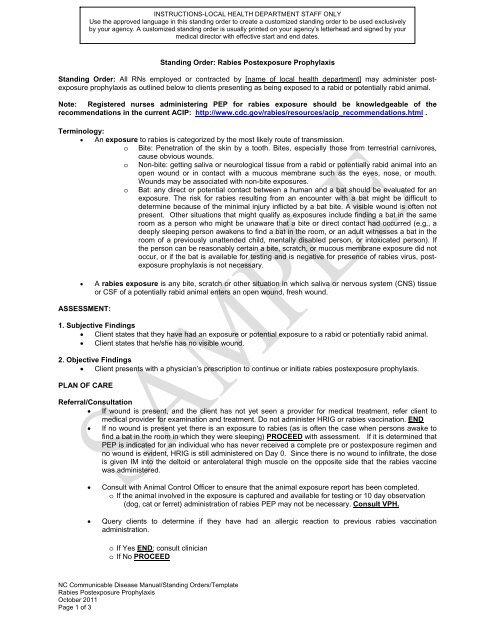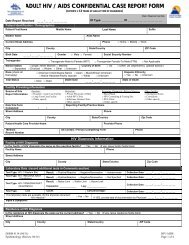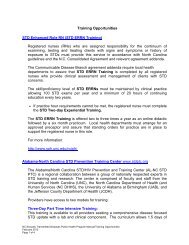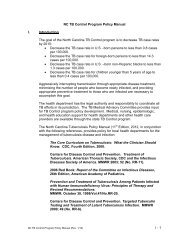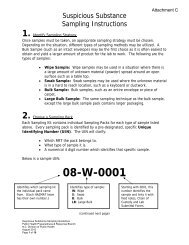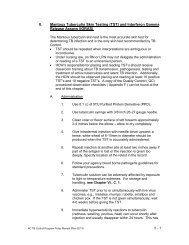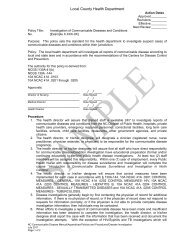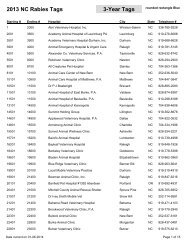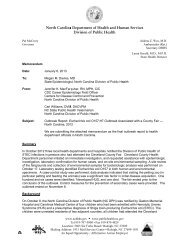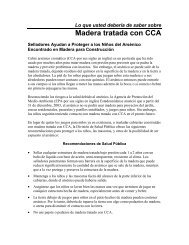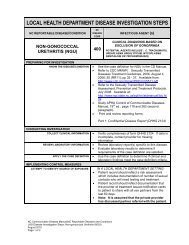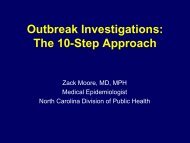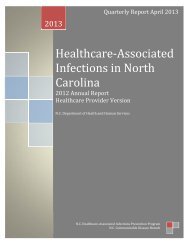Standing Order for Rabies Post Exposure Prophylaxis - Epi
Standing Order for Rabies Post Exposure Prophylaxis - Epi
Standing Order for Rabies Post Exposure Prophylaxis - Epi
- No tags were found...
You also want an ePaper? Increase the reach of your titles
YUMPU automatically turns print PDFs into web optimized ePapers that Google loves.
INSTRUCTIONS-LOCAL HEALTH DEPARTMENT STAFF ONLYUse the approved language in this standing order to create a customized standing order to be used exclusivelyby your agency. A customized standing order is usually printed on your agency’s letterhead and signed by yourmedical director with effective start and end dates.<strong>Standing</strong> <strong>Order</strong>: <strong>Rabies</strong> <strong>Post</strong>exposure <strong>Prophylaxis</strong><strong>Standing</strong> <strong>Order</strong>: All RNs employed or contracted by [name of local health department] may administer postexposureprophylaxis as outlined below to clients presenting as being exposed to a rabid or potentially rabid animal.Note: Registered nurses administering PEP <strong>for</strong> rabies exposure should be knowledgeable of therecommendations in the current ACIP: http://www.cdc.gov/rabies/resources/acip_recommendations.html .Terminology: An exposure to rabies is categorized by the most likely route of transmission.o Bite: Penetration of the skin by a tooth. Bites, especially those from terrestrial carnivores,cause obvious wounds.o Non-bite: getting saliva or neurological tissue from a rabid or potentially rabid animal into anopen wound or in contact with a mucous membrane such as the eyes, nose, or mouth.Wounds may be associated with non-bite exposures.o Bat: any direct or potential contact between a human and a bat should be evaluated <strong>for</strong> anexposure. The risk <strong>for</strong> rabies resulting from an encounter with a bat might be difficult todetermine because of the minimal injury inflicted by a bat bite. A visible wound is often notpresent. Other situations that might qualify as exposures include finding a bat in the sameroom as a person who might be unaware that a bite or direct contact had occurred (e.g., adeeply sleeping person awakens to find a bat in the room, or an adult witnesses a bat in theroom of a previously unattended child, mentally disabled person, or intoxicated person). Ifthe person can be reasonably certain a bite, scratch, or mucous membrane exposure did notoccur, or if the bat is available <strong>for</strong> testing and is negative <strong>for</strong> presence of rabies virus, postexposureprophylaxis is not necessary.A rabies exposure is any bite, scratch or other situation in which saliva or nervous system (CNS) tissueor CSF of a potentially rabid animal enters an open wound, fresh wound.ASSESSMENT:1. Subjective Findings Client states that they have had an exposure or potential exposure to a rabid or potentially rabid animal. Client states that he/she has no visible wound.2. Objective Findings Client presents with a physician’s prescription to continue or initiate rabies postexposure prophylaxis.PLAN OF CAREReferral/Consultation If wound is present, and the client has not yet seen a provider <strong>for</strong> medical treatment, refer client tomedical provider <strong>for</strong> examination and treatment. Do not administer HRIG or rabies vaccination. END If no wound is present yet there is an exposure to rabies (as is often the case when persons awake tofind a bat in the room in which they were sleeping) PROCEED with assessment. If it is determined thatPEP is indicated <strong>for</strong> an individual who has never received a complete pre or postexposure regimen andno wound is evident, HRIG is still administered on Day 0. Since there is no wound to infiltrate, the doseis given IM into the deltoid or anterolateral thigh muscle on the opposite side that the rabies vaccinewas administered.Consult with Animal Control Officer to ensure that the animal exposure report has been completed.o If the animal involved in the exposure is captured and available <strong>for</strong> testing or 10 day observation(dog, cat or ferret) administration of rabies PEP may not be necessary. Consult VPH.Query clients to determine if they have had an allergic reaction to previous rabies vaccinationadministration.o If Yes END; consult cliniciano If No PROCEEDNC Communicable Disease Manual/<strong>Standing</strong> <strong>Order</strong>s/Template<strong>Rabies</strong> <strong>Post</strong>exposure <strong>Prophylaxis</strong>October 2011Page 1 of 3
If HRIG is indicated but not given on Day 0, contact the ordering physician. HRIG can be administeredup to and including Day 7 of the postexposure prophylaxis series.If there is any deviation from vaccine schedule consult with ordering provider and VPH, if necessary.2. Implementation:<strong>Exposure</strong>s to rabies warrant immediate wound care and administration of rabies postexposure prophylaxis. It isimportant to note that not all exposures to rabies cause visible wounds.Day 0 3 7 14 28PEP <strong>for</strong>PreviouslyUnvaccinatedPersons1.0 ml vaccine IM(deltoid) & 20 IU/kgHRIG*1.0 ml vaccineIM (deltoid)1.0 ml vaccineIM (deltoid)1.0 ml vaccineIM (deltoid)No vaccinegivenPEP <strong>for</strong>PreviouslyVaccinatedPersons1.0 ml vaccine IM(deltoid)HRIG is NOTadministered1.0 ml vaccineIM (deltoid)No vaccinegivenNo vaccinegivenNo vaccinegivenNote: Day 0 is the day PEP is initiated and may not be the day of actual exposure.* Consult Physician. If anatomically feasible, the full dose of HRIG should be thoroughly infiltrated in thearea around and into the wounds. Any remaining volume should be injected IM at a site distant fromvaccine administration (i.e., deltoid on same side as wound and on opposite side of rabies vaccine). HRIGis administered on Day 0 to individuals who have never received a complete pre or postexposure regimenregardless of whether a wound is evident or not. Never administer rabies vaccine or HRIG in the glutealmuscle. Consult Physician if client is immunocompromised. A 5 th dose of vaccine may be indicated, refer to 2010ACIP http://www.cdc.gov/mmwr/preview/mmwrhtml/rr5902a1.htm3. Nursing action Educate the client on the importance of completing vaccination series. Review vaccine side effects and emergency instructions. Offer and administer Td/Tdap per standing orders protocol if cannot confirm received vaccine in the last 10years.4. Reporting Document HRIG and rabies vaccine administration into NC Immunization Registry. Report any adverse reactions to vaccines to the Federal Vaccine Adverse Event Reporting System(VAERS): http://vaers.hhs.gov/esub/index and to manufacturer, see 2008 ACIPhttp://www.cdc.gov/mmwr/preview/mmwrhtml/rr5703a1.htmApproved by: ____________________________________ Date Signed: ___________________Local Health Department Medical DirectorEffective Date: ______________Expiration Date: _____________NC Communicable Disease Manual/<strong>Standing</strong> <strong>Order</strong>s/Template<strong>Rabies</strong> <strong>Post</strong>exposure <strong>Prophylaxis</strong>October 2011Page 2 of 3
Resources:Guidelines <strong>for</strong> rabies exposure risk assessment2008 ACIP: http://www.cdc.gov/mmwr/preview/mmwrhtml/rr5703a1.htmGuidelines <strong>for</strong> reduced dose rabies post exposure vaccine administration2010 ACIP: http://www.cdc.gov/mmwr/preview/mmwrhtml/rr5902a1.htmFor questions, consult with North Carolina Veterinary Public Health at (919) 733-3419.Legal Authority: Nurse Practice Act, G.S. 90-171.20 (7) (f) & (8) (c)NC Communicable Disease Manual/<strong>Standing</strong> <strong>Order</strong>s/Template<strong>Rabies</strong> <strong>Post</strong>exposure <strong>Prophylaxis</strong>October 2011Page 3 of 3


